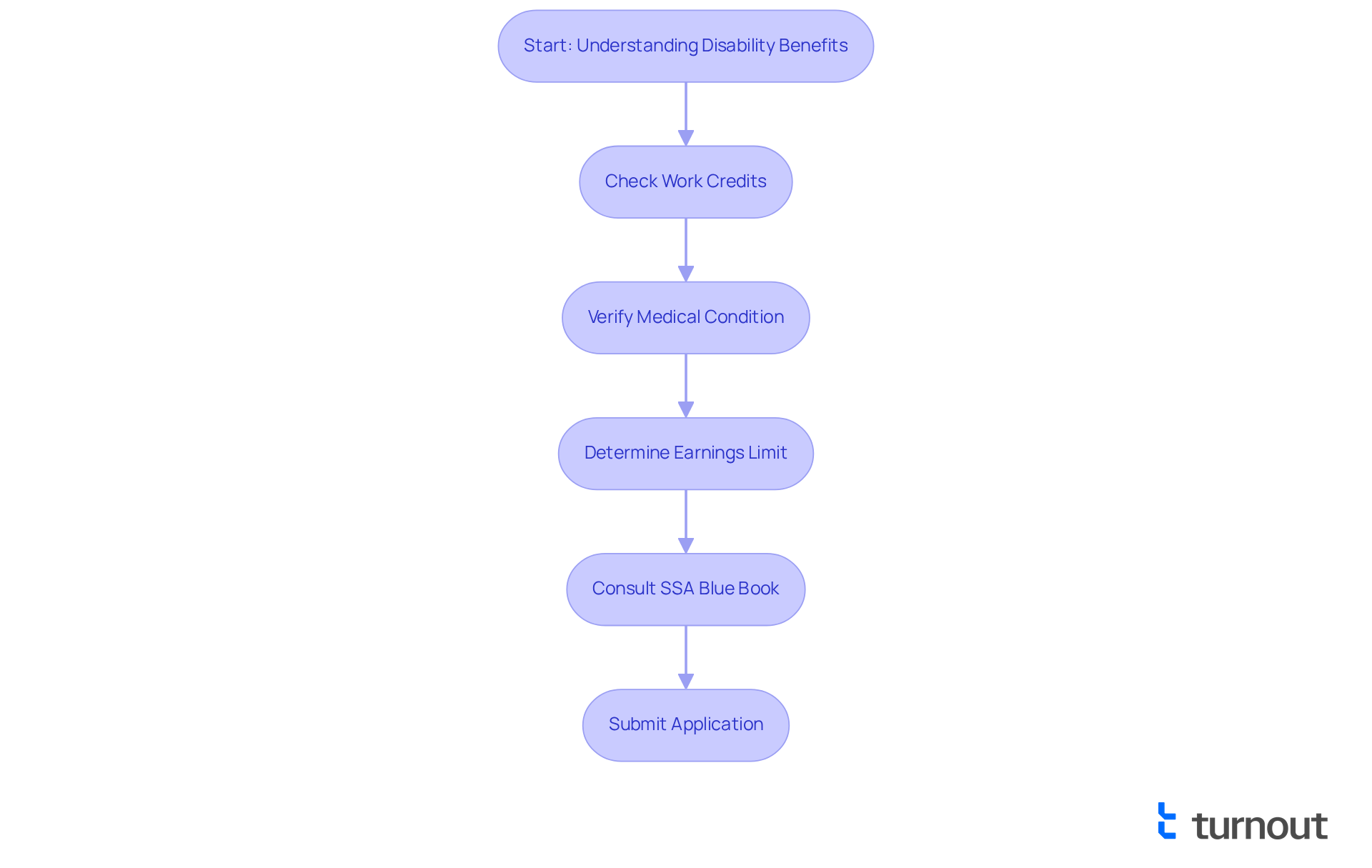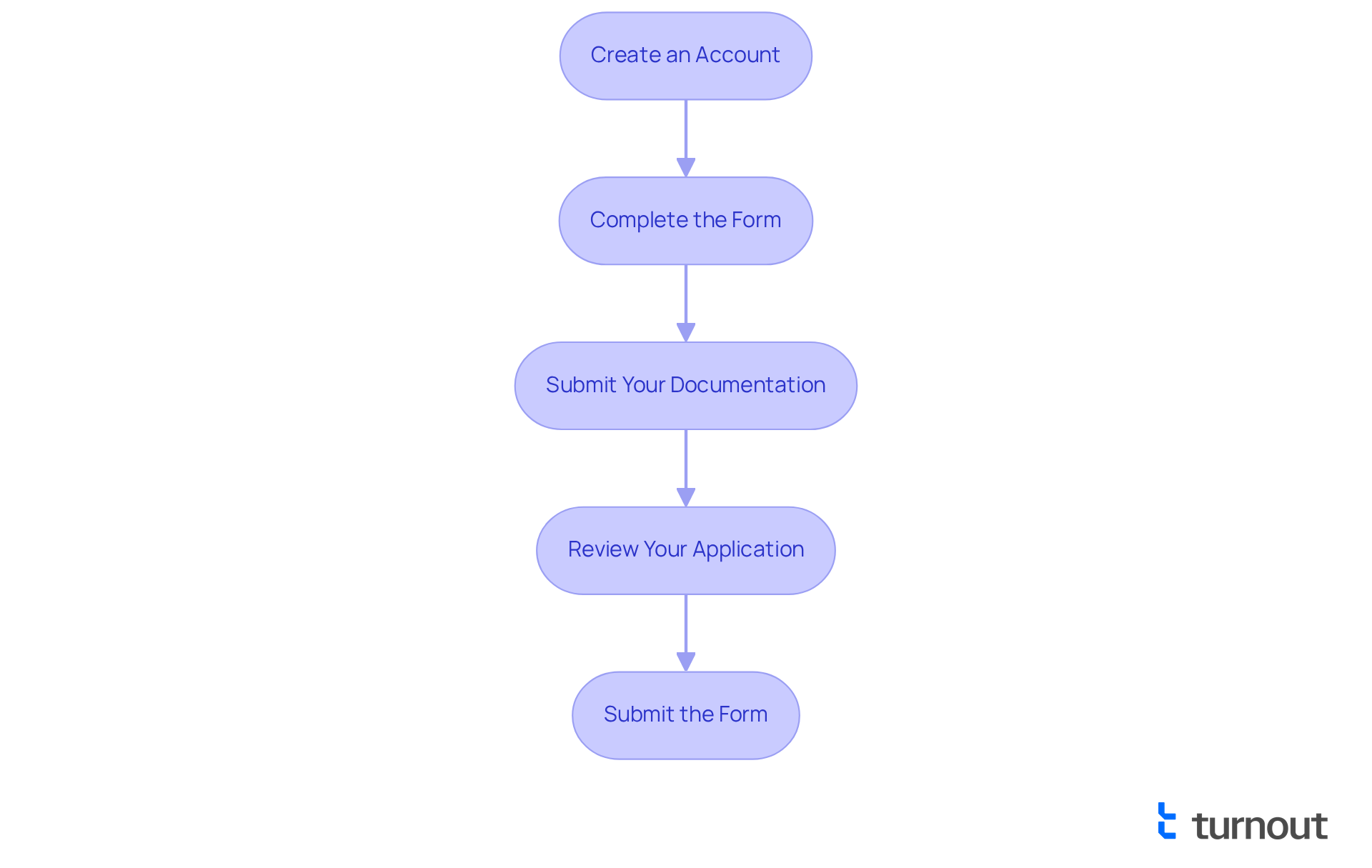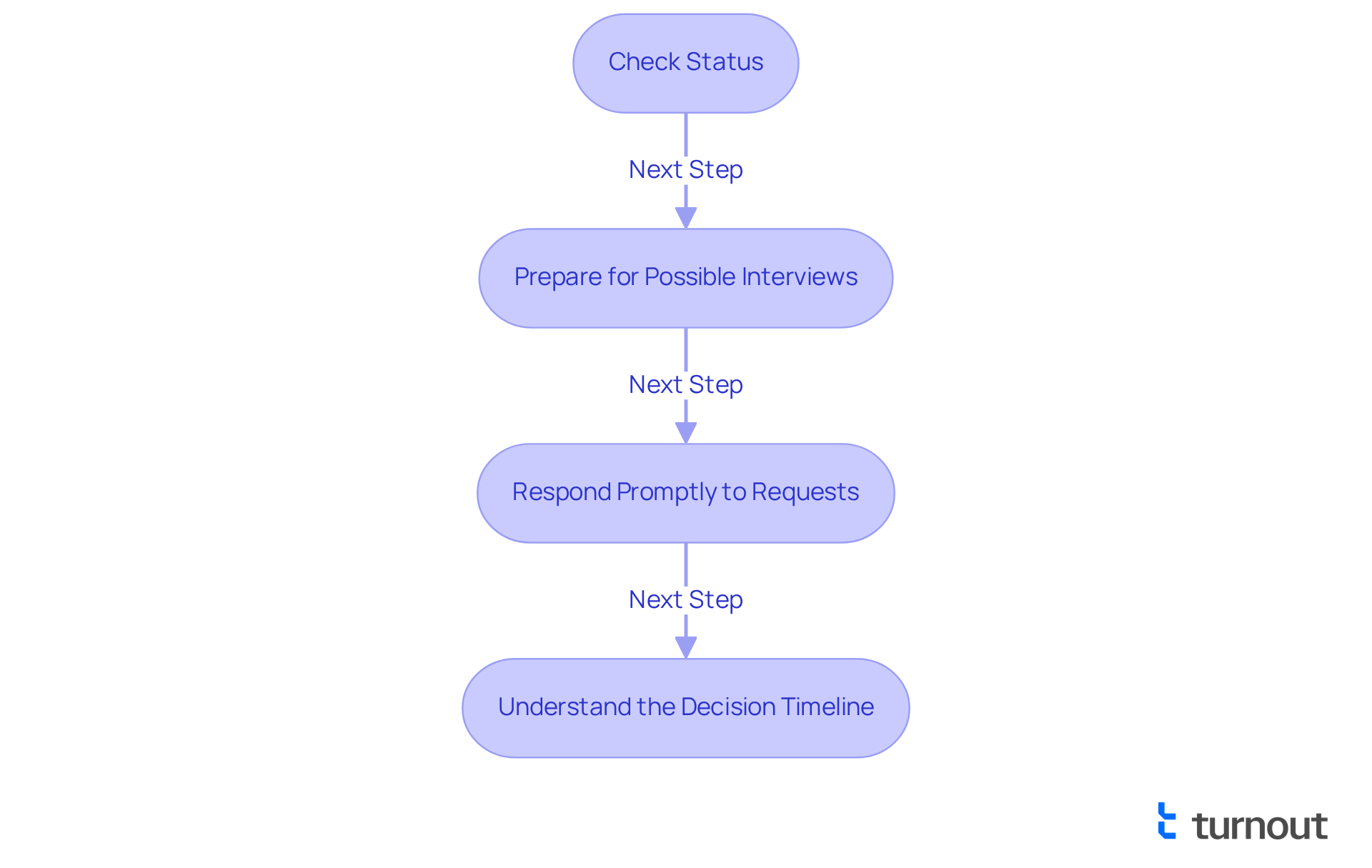Overview
Navigating the process of signing up for disability benefits can feel overwhelming, but we're here to help. This article outlines a four-step journey designed to support you every step of the way.
- First, we focus on understanding your eligibility, acknowledging that this is often the most challenging part.
- Next, we guide you in gathering the required documentation, emphasizing the importance of accuracy and timeliness in your responses to SSA requests. These elements significantly enhance your chances of a successful application.
- As you move forward, we provide clear instructions for navigating the application submission process. It's common to feel uncertain during this stage, but rest assured that with the right guidance, you can approach it confidently.
- Finally, we discuss how to track your application status, ensuring you stay informed and empowered throughout this journey.
Remember, you are not alone in this process. Each step is supported by detailed guidance to help you take the necessary actions with care and consideration.
Introduction
Navigating the disability benefits application process can feel overwhelming. Many applicants face complexities that leave them uncertain and anxious. We understand that understanding the eligibility criteria and required documentation is crucial for those seeking assistance through Social Security Disability Insurance (SSDI) or Supplemental Security Income (SSI). Despite clear guidelines, it's disheartening to see so many applications denied. You might be wondering: how can you increase your chances of a successful application? This guide outlines four essential steps to streamline the disability sign-up process, empowering you to confidently pursue the benefits you deserve. Remember, you are not alone in this journey, and we're here to help.
Understand Disability Benefits and Eligibility Criteria
Navigating the process of disability sign up for Social Security Disability Insurance (SSDI) or Supplemental Security Income (SSI) can feel overwhelming. We understand that many applicants face challenges, and it's essential to know that you are not alone in this journey. To qualify, you must meet specific criteria. Generally, you need to have worked for a certain period, typically requiring 40 work credits, with 20 earned in the last 10 years. Additionally, you must demonstrate a medical issue that significantly hinders your ability to work.
For 2025, it's important to note that the earnings limit is set at $1,620 per month for non-blind individuals, while the limit for statutorily blind individuals is $2,700. Your situation must also be anticipated to persist for a minimum of 12 months or lead to death. It's common to feel discouraged about disability sign up, especially considering that about two-thirds of initial SSDI applications are denied. This highlights the need to thoroughly understand the criteria for disability sign up.
Familiarizing yourself with the SSA's Blue Book is crucial, as it outlines the medical conditions that qualify for benefits. Moreover, examining your earnings statements will assist in confirming that you satisfy the revised work credit criteria. Grasping these standards will empower you to decide whether to move forward with your submission and enhance your likelihood of success. Remember, we’re here to help you through this process every step of the way.

Gather Required Documentation for Your Application
To ensure a smooth application process for Social Security Disability Insurance (SSDI), we understand that gathering the necessary documents can feel overwhelming. Here’s a helpful checklist to guide you:
- Personal Information: Include your Social Security number, birth certificate, and proof of U.S. citizenship or lawful alien status.
- Medical Records: Obtain comprehensive medical documentation from your healthcare providers. This should include diagnoses, treatment history, and relevant test results that illustrate the severity of your health issue.
- Work History: Compile a detailed list of your employment over the past 15 years. This should include job titles, dates of employment, and reasons for leaving each position.
- Financial Information: Prepare documentation of your income and resources, such as bank statements and tax returns, to demonstrate your financial situation.
- Disability Report: Complete the SSA-3368 form, which provides in-depth information about your condition and its impact on your daily life.
Having these documents arranged can greatly enhance the process, minimizing delays and increasing your likelihood of obtaining the benefits you deserve. On average, gathering the necessary documentation can take several weeks, so starting early is advisable. As Dr. Bill LaTour, mentions, "A skilled disability advocate can help with submitting your request, collecting the appropriate evidence, and representing you if your claim is rejected." Additionally, it is essential to keep copies of all documents submitted to the SSA to avoid issues with missing or incomplete paperwork. Remember, you are not alone in this journey; over 5 million Americans seek assistance with disability benefits due to illness or injury. Thorough preparation is essential, and we’re here to help.

Navigate the Application Process: Step-by-Step Submission
To successfully submit your application for Social Security Disability Insurance (SSDI), we encourage you to follow these essential steps:
-
Create an Account: Start by visiting the Administration's website to establish your 'my Account' profile. This account will empower you to manage your request online, track its status, and access vital information about your benefits. Social Insurance specialists emphasize that having this account is crucial for effectively handling your request.
-
Complete the Form: Fill out the SSDI or Supplemental Security Income (SSI) request form (SSA-16) either online or in person. It’s important to provide thorough and honest responses, as accuracy is key to your submission’s success. Remember, about 10.9 million disabled workers and dependents received disability benefits in December 2022, highlighting the significance of this process.
-
Submit Your Documentation: Gather and upload or mail all necessary documents that support your request. Consistency across all forms is vital; discrepancies can lead to complications or delays in processing.
-
Review Your Application: Before finalizing your submission, take a moment to carefully review all entries for accuracy and completeness. Incomplete forms can significantly prolong processing times, which currently average several months for online submissions compared to longer durations for in-person requests. It’s also essential to track your earnings and report them monthly to the SSA to maintain your benefits.
-
Submit the Form: Once you’ve confirmed that everything is in order, submit your request. You will receive a confirmation of submission, which is crucial for monitoring your case and ensuring that your request is being processed. If you have a specific medical condition, don’t hesitate to inquire about the possibility of expedited submissions, as some instances can be handled more quickly.
By following these steps, you can navigate the SSDI procedure more effectively, which will improve your chances of a successful disability sign up. Remember, approximately 38% of applicants who meet the technical requirements are accepted initially, and 53% of those who appeal the initial decision are ultimately approved. Additionally, understanding the Extended Period of Medicare Coverage (EPMC) and the Medi-Cal Working Disabled Program can help you maintain healthcare coverage while working. You're not alone in this journey; we're here to help.

Track Your Application and Prepare for Follow-Up Actions
After submitting your application, we understand that staying on track can feel overwhelming. Here are some essential steps to help you navigate this process:
-
Check Status: Regularly log into your 'my Social Security' account to monitor your status. Alternatively, you can call the SSA at 1-800-772-1213 for updates on your case. Keeping informed can ease some of your worries.
-
Prepare for Possible Interviews: It's common to feel anxious about a potential interview with an SSA representative. Take time to review your submission thoroughly and think about how your condition affects your daily life. Statistics indicate that approximately 60% of applicants may be called for interviews, making preparation crucial. As disability advocate Jane Doe wisely states, "Preparation is key; understanding your submission thoroughly can make a significant difference in the outcome."
-
Respond Promptly to Requests: If the SSA requests additional information or documentation, please respond as quickly as possible. We know that delays in supplying requested materials can extend the decision-making process, which currently averages around 240 days for initial submissions. Your timely response can help keep things moving.
-
Understand the Decision Timeline: The decision process can take several months, and if your application is denied, you have the right to appeal within 60 days. Familiarizing yourself with the appeals process is important, as many applicants face lengthy waits—up to 839 days in some cases—before receiving a final decision. Being prepared can help you navigate this challenging journey more effectively. Remember to avoid common pitfalls such as missing deadlines or failing to provide complete information, as these can lead to further delays. You are not alone in this journey; we’re here to help you every step of the way.

Conclusion
Navigating the disability benefits application process can feel overwhelming, but understanding the essential steps can truly ease your journey. This article offers a clear, structured approach to applying for Social Security Disability Insurance (SSDI) or Supplemental Security Income (SSI). It emphasizes the importance of:
- Knowing eligibility criteria
- Gathering necessary documentation
- Submitting applications accurately
- Tracking your progress effectively
We know that thorough preparation is critical. Understanding the SSA's requirements and ensuring all documentation is complete and accurate are vital steps. It's important to note that about two-thirds of initial SSDI applications face denial, which highlights the necessity for meticulousness at every stage of the application process. Staying informed and responsive after submission is equally valuable, as timely follow-up actions can significantly influence the outcome of your application.
Ultimately, you do not have to face the journey to securing disability benefits alone. With the right knowledge and support, you can navigate the complexities of the system with greater confidence. By taking proactive steps and remaining informed throughout the process, you can enhance your chances of success and ensure you receive the benefits you deserve. Remember, we’re here to help, and you are not alone in this journey.
Frequently Asked Questions
What are the main disability benefits available through Social Security?
The main disability benefits available are Social Security Disability Insurance (SSDI) and Supplemental Security Income (SSI).
What are the eligibility criteria for SSDI and SSI?
To qualify for SSDI, you generally need to have worked for a certain period, typically requiring 40 work credits, with 20 earned in the last 10 years. You must also demonstrate a medical issue that significantly hinders your ability to work. SSI eligibility criteria include financial need and having a qualifying disability.
What is the earnings limit for disability benefits in 2025?
For 2025, the earnings limit is set at $1,620 per month for non-blind individuals and $2,700 for statutorily blind individuals.
How long must a medical issue persist to qualify for disability benefits?
The medical issue must be anticipated to persist for a minimum of 12 months or lead to death to qualify for disability benefits.
What percentage of initial SSDI applications are denied?
About two-thirds of initial SSDI applications are denied.
How can I familiarize myself with the qualifications for disability benefits?
Familiarizing yourself with the SSA's Blue Book is crucial, as it outlines the medical conditions that qualify for benefits.
Why is it important to examine my earnings statements?
Examining your earnings statements will assist in confirming that you satisfy the revised work credit criteria necessary for disability benefits.
What resources are available to help me with the disability application process?
It is important to seek assistance and guidance throughout the application process, as there are resources available to help you every step of the way.




